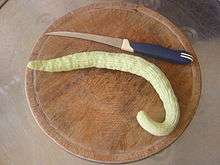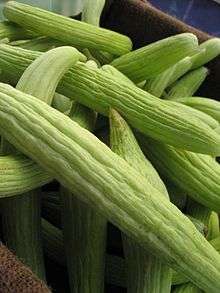Armenian cucumber
[1]The Armenian cucumber, Cucumis melo var. flexuosus, is a type of long, slender fruit which tastes like a cucumber and looks somewhat like a cucumber inside. It is actually a variety of muskmelon (C. melo), a species closely related to the cucumber (C. sativus). It is also known as the yard-long cucumber, snake cucumber, snake melon, tirozî in Kurdish, uri in Japanese, Acur in Turkish, Kakri in Hindi, Tar in Punjabi, commarella or tortarello in Italian. It should not be confused with the snake gourds (Trichosanthes spp.). The skin is very thin, light green, and bumpless. It has no bitterness and the fruit is almost always used without peeling. It is also sometimes called a "gutah".[2]
| “Mekti,” or Mediterranean Cucumber | |
|---|---|
 | |
| Scientific classification | |
| Kingdom: | |
| (unranked): | |
| (unranked): | |
| (unranked): | |
| Order: | |
| Family: | |
| Genus: | |
| Species: | C. melo |
| Variety: | C. m. var. flexuosus |
| Trinomial name | |
| Cucumis melo var. flexuosus (L.) Naudin. | |
Description

The Armenian cucumber grows approximately 30 to 36 inches (76 to 91 cm) long. It grows equally well on the ground or on a trellis. Armenian cucumber plants prefer to grow in full sun for most of the day. The fruit is most flavorful when it is 12 to 15 inches (30 to 38 cm) long. Pickled Armenian cucumber is sold in Middle Eastern markets as "Pickled Wild Cucumber".[3]
History
Fredric Hasselquist, in his travels in Asia Minor, Egypt, Cyprus and Palestine in the 18th century, came across the "Egyptian or hairy cucumber, Cucumis chate", which is today included in the Armenian variety. It is said by Hasselquist to be the “queen of cucumbers, refreshing, sweet, solid, and wholesome.” He also states “they still form a great part of the food of the lower-class people in Egypt serving them for meat, drink and physic.” George E. Post, in Hastings' Dictionary of the Bible, states, “It is longer and more slender than the common cucumber, being often more than a foot long, and sometimes less than an inch thick, and pointed at both ends.” The Cucumis melo subspecies Chate was the most frequently encountered cucurbit in ancient Mediterranean images and texts, and was most likely the type of cucumber grown year-round for Emperor Tiberius of 1st century Rome.[4]
A study published in 2018 concluded that melon yields in Israel can be improved by selection of local landraces. The study examined landraces collected from 42 fields, finding extensive variations in certain traits that could be cultivated to improve the local production.[5]
References
- "Armenian Cucumber". Have A Plant. Retrieved 2020-03-30.
- http://greengopost.com/armenian-cucumbers-vineyard-farmers-market-fresno/
- Wild Cucumbers Got You In a Pickle?
- Paris, Harry; Janick, J. (2008-05-20). "Reflections on linguistics as an aid to taxonomical identification of ancient Mediterranean cucurbits: the Piqqus of the Faqqous1". Cite journal requires
|journal=(help) - Omari, Samer; Kamenir, Yuri; Benichou, Jennifer I. C.; Pariente, Sarah; Sela, Hanan; Perl-Treves, Rafael (2018). "Landraces of snake melon, an ancient Middle Eastern crop, reveal extensive morphological and DNA diversity for potential genetic improvement". BMC Genetics. 19 (1): 34. doi:10.1186/s12863-018-0619-6. PMC 5966880. PMID 29792158.
External links
- " Multilingual taxonomic information". University of Melbourne.
- Fact sheet from the University of Florida (with photo)